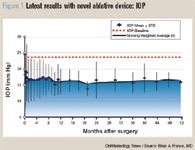Article
Trabeculotomy surgery maintains favorable profile
Author(s):
A review of outcomes from 498 eyes that have undergone trabeculectomy ab interno surgery with a novel ablative device (Trabectome, NeoMedix) for open-angle glaucoma show that the procedure is very safe and maintains IOP in the range of 14 to 16 mm Hg.

Key Points

"The . . . procedure has lower risks of hypotony and infection than external filtering surgery and it involves simpler follow-up," Dr. Francis said. "Based on such features and our results, we consider . . . surgery [with the device] a safer alternative to trabeculectomy and other filtering procedures and therefore preferred for appropriate eyes, which we would define by a diagnosis of open-angle glaucoma, a clear gonioscopic view, and with a target IOP in the range of 14 to 16 mm Hg."
Dr. Francis is associate professor of clinical ophthalmology, Doheny Eye Institute, Keck School of Medicine, University of Southern California, Los Angeles.

The procedure has been performed in more than 800 eyes so far either as a solo procedure or in combination with phacoemulsification. At a glaucoma free paper session, Dr. Francis presented results from 498 eyes that underwent the glaucoma procedure only. He noted, however, that it is easily combined with cataract surgery because both procedures can be done through a single temporal, clear corneal incision.
Mean ± SD IOP at baseline for the 498 eyes was 25.2 ± 7.9 mm Hg. Significant IOP lowering was achieved immediately by day 1 postsurgery (mean 16.6 ± 9.5 mm Hg), and IOP was reduced by about 38% to 15.7 ± 3.3 mm Hg in 240 eyes seen at 12 months.
Only 39 eyes had reached 2 years of follow-up, and the longest duration of follow-up is 52 months, although only three eyes have been seen at that interval. Mean IOP at all postoperative visits after 12 months has been maintained in the range of 15.7 to 17.0 mm Hg, however, Dr. Francis reported.
The reductions in IOP were achieved with a decrease in glaucoma medication use. At baseline, patients were using a mean of 2.9 medications for glaucoma control. At 12 months, the average number of medications used per patient was decreased by nearly half to 1.55, and the average number continued to decline during longer follow-up.
Reviewing complications, Dr. Francis noted that blood reflux from Schlemm's canal occurred intraoperatively in 370 eyes (74%). This event, however, really represents the treatment endpoint, because an open connection has been established between the anterior chamber and aqueous veins and has not been associated with significant consequences postoperatively, he said.
Newsletter
Don’t miss out—get Ophthalmology Times updates on the latest clinical advancements and expert interviews, straight to your inbox.




